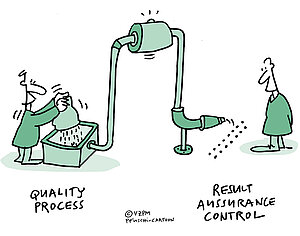Quality
Definition
Quality in projects has two key drivers. On the one hand, it is about the quality of the process, the way in which the project is organised. This is about developing, implementing and reviewing standards for the way quality is addressed in component sub-projects and tasks. On the other hand, it is about managing, assuring and controlling the quality of the output and outcome of the project. Quality encompasses the entire project from initiation to posttransition, throughout the whole lifecycle.
Purpose
The purpose of this competence element is to enable the individual to establish and manage the quality of the service/product to be delivered and the delivery process being managed; and to recognise quality as an invaluable tool for the benefits realisation management process.
Description
Quality in projects is on the one hand about ensuring the right quality of intermediate services or products delivered specific to the project. On the other hand, it is about ensuring that quality processes are well implemented throughout the project. Ensuring quality processes are well implemented means setting a standard and measuring its effectiveness. Usually this is based upon the quality standards and methods of the organisation behind the project, as sponsor or as supplier. These should be tailored towards this project and then implemented, measured and adapted.
Key competence indicators
Develop and monitor the implementation of and revise a quality management plan for the project
The purpose of managing the quality is to plan and guarantee the quality requirements and standards applicable to the project and the project deliverables. Planning of the quality includes determining and agreeing with the project sponsor/owner and other key stakeholders on the quality objectives to be achieved. It includes defining indicators and setting quality target values for those indicators in the project at hand. It includes establishing the tools, procedures, techniques and resources necessary to achieve the quality objectives. It also includes developing the quality plan, including type of reviews, responsibilities, participants and a time schedule developed in accordance with the overall project time schedule. It includes the monitoring and assessment of the tasks defined in the plan and closing the quality tasks, like all others in the project.
Measures
- Develops and monitors a quality plan
- Names different types of quality objectives
- Implements measures to achieve defined quality objectives
- Defines and implements quality measures
- Explains and names different types of tools/techniques for achieving quality objectives
- Explains and names procedures for achieving quality objectives
- Explains how to align the quality management activities to the overall project activities and also refers to own experiences (projects)
Review the project and its deliverables to ensure that they continue to meet the requirements of the quality management plan
The purpose of performing quality management is to continuously review the project and the project deliverables. It encompasses all processes, tools, procedures, techniques and resources necessary to meet the defined and planned quality objectives. The quality management process ensures that the quality goals to be achieved are communicated, understood, accepted and followed by the members of the temporary project organisation. The process also includes executing the quality plan as the project progresses, revising it and delivering indicators of its fulfilment. Quality audits can be performed by various parties, by people from inside or outside the temporary project organisation, or even by external parties such as customers. Audits serve a relevant and important purpose, as they determine the performance of the quality process, the quality control and their output must be analysed to determine the need for corrective and preventive actions or change requests. Quality audits can also be used as a means of reporting progress.
Measures
- Explains different ways of reviewing the project performance and the project processes
- Names key elements necessary for an effective and efficient project review
- Explains how to communicate project quality objectives
- Names different reasons for performing a project audit
- Performs a quality audit
- Analyses a quality audit and is able to define measures or change requests
- Presents at least one example of a corrective action
Verify the achievement of project quality objectives and recommend any necessary corrective and/or preventive actions
The purpose of performing verification is to determine whether the established project quality requirements, objectives and standards are being met, in each phase of the project development. The process of performing verification is done during the entire project lifecycle, usually at the end of each phase. It includes establishing whether the quality of the project deliverables and processes is being met and detecting defects by using established tools, procedures and techniques. It also includes analysing possible causes of defects, determining the appropriate corrective and preventive actions and formulating recommendable change requests. Finally it includes communicating the recommended corrective and preventive actions and change requests to relevant members of both the temporary and permanent project organisation.
Parties representing the permanent organisation may perform verification activities. It has been proven that it is more cost-efficient to perform verification at early stages of the development of the project, instead of leaving verification to the end of the project.
Measures
- Describes the outcome of a planned and performed verification process referring to own experiences gained on projects
- Explains the contents and outputs of a root cause analysis carried out on the basis of detected defects
- Explains the process and goals of peer reviews
- Performs verification and recommends corrective actions
- Outlines the contents and steps in communicating preferred and recommended corrective actions and change requests, referring to own experiences gained on projects
Plan and organise the validation of project outcomes
It is often not feasible to assess whether a specific, measurable, achievable and timed goal or objective is met or not, or the degree or percentage to which the goal or objective is met. The anticipated value gained from a project by means of the project deliverables is an example of this, as it is often difficult to measure and verify explicitly. In such cases, validation is a feasible way to determine the quality level of the value gained from the project outcome. The goal of validation is to create a formal acceptance by the client of the project.
Validation is typically performed by either the permanent organisation or other external parties (e.g. customers) and rarely by the temporary organisation itself. However, it is the responsibility of the individual to plan and organise the validation. Validation can be done in various ways: in a single event or as a process to ensure continuous validation.
Measures
- Explains the difference between verifying and validating
- Documents different types of quality objectives suitable for quality validation
- Conducts a validation exercise of project outcomes
- Obtains a term of acceptance from a client
Ensure quality throughout the project
Based upon the quality procedures both of the organisations and the suppliers, a quality approach for the project is chosen and implemented. It should be fit for purpose and implementable with relative ease. Adaptation, integration and implementation will require dealing with several organisations (or parts of organisations) who all prefer doing it their own way. Once implemented, regular check-ups and improvements need to take place to maintain the fitness for purpose. Since quality is about people, not just about processes, special attention should be paid to quality awareness and ‘the right quality for this project’.
Measures
- Assesses, adapts and integrates quality standards being used by organisations
- Implements quality processes in the project
- Conducts regular assessments of the implemented processes and improves them when needed
- Implements quality awareness in the project, so that everyone involved knows what quality is required
- Conducts regular assessments of the quality awareness and takes corrective action when needed


